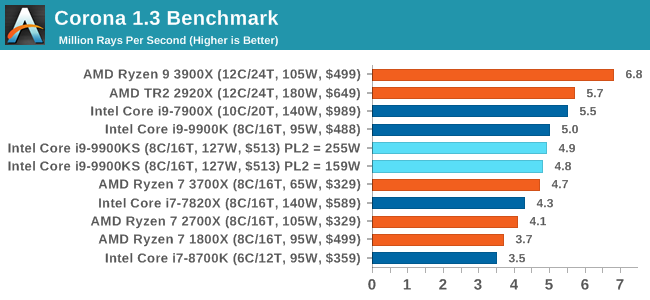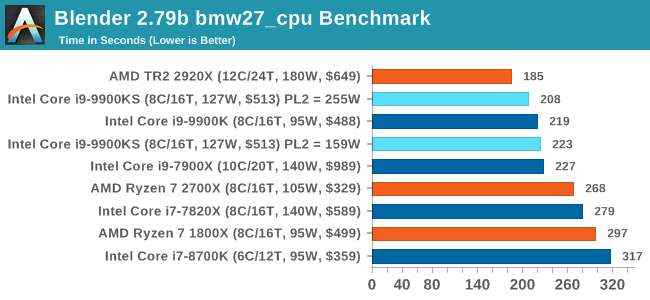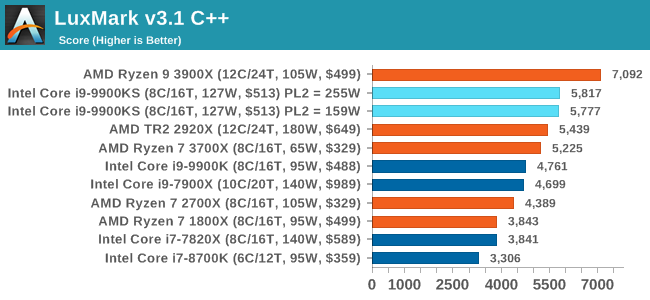The Intel Core i9-9900KS Review: The 5 GHz Consumer Special
by Dr. Ian Cutress on October 31, 2019 10:45 AM ESTCPU Performance: Rendering Tests
Rendering is often a key target for processor workloads, lending itself to a professional environment. It comes in different formats as well, from 3D rendering through rasterization, such as games, or by ray tracing, and invokes the ability of the software to manage meshes, textures, collisions, aliasing, physics (in animations), and discarding unnecessary work. Most renderers offer CPU code paths, while a few use GPUs and select environments use FPGAs or dedicated ASICs. For big studios however, CPUs are still the hardware of choice.
All of our benchmark results can also be found in our benchmark engine, Bench.
Corona 1.3: Performance Render
An advanced performance based renderer for software such as 3ds Max and Cinema 4D, the Corona benchmark renders a generated scene as a standard under its 1.3 software version. Normally the GUI implementation of the benchmark shows the scene being built, and allows the user to upload the result as a ‘time to complete’.
We got in contact with the developer who gave us a command line version of the benchmark that does a direct output of results. Rather than reporting time, we report the average number of rays per second across six runs, as the performance scaling of a result per unit time is typically visually easier to understand.
The Corona benchmark website can be found at https://corona-renderer.com/benchmark

Interestingly both 9900KS settings performed slightly worse than the 9900K here, which you wouldn't expect given the all-core turbo being higher. It would appear that there is something else the bottleneck in this test.
Blender 2.79b: 3D Creation Suite
A high profile rendering tool, Blender is open-source allowing for massive amounts of configurability, and is used by a number of high-profile animation studios worldwide. The organization recently released a Blender benchmark package, a couple of weeks after we had narrowed our Blender test for our new suite, however their test can take over an hour. For our results, we run one of the sub-tests in that suite through the command line - a standard ‘bmw27’ scene in CPU only mode, and measure the time to complete the render.
Blender can be downloaded at https://www.blender.org/download/

All the 9900 parts and settings perform roughly the same with one another, however the PL2 255W setting on the 9900KS does allow it to get a small ~5% advantage over the standard 9900K.
LuxMark v3.1: LuxRender via Different Code Paths
As stated at the top, there are many different ways to process rendering data: CPU, GPU, Accelerator, and others. On top of that, there are many frameworks and APIs in which to program, depending on how the software will be used. LuxMark, a benchmark developed using the LuxRender engine, offers several different scenes and APIs.
In our test, we run the simple ‘Ball’ scene on both the C++ and OpenCL code paths, but in CPU mode. This scene starts with a rough render and slowly improves the quality over two minutes, giving a final result in what is essentially an average ‘kilorays per second’.

Both 9900KS settings perform equally well here, and a sizeable jump over the standard 9900K.
POV-Ray 3.7.1: Ray Tracing
The Persistence of Vision ray tracing engine is another well-known benchmarking tool, which was in a state of relative hibernation until AMD released its Zen processors, to which suddenly both Intel and AMD were submitting code to the main branch of the open source project. For our test, we use the built-in benchmark for all-cores, called from the command line.
POV-Ray can be downloaded from http://www.povray.org/

One of the biggest differences between the two power settings is in POV-Ray, with a marked frequency difference. In fact, the 159W setting on the 9900KS puts it below our standard settings for the 9900K, which likely had an big default turbo budget on the board it was on at the time.











235 Comments
View All Comments
airdrifting - Thursday, October 31, 2019 - link
What a joke and pos, and they have the audacity to claim 127W TDP?9900K out of box without messing with BIOS is drawing 180 watt at default 4.7GHz turbo, you expect me to believe 127W TDP? I know fanboys are going to defend TDP is not actual power usage blah blah blah, but it should be used as a point of reference and frankly actual power draw is 100% over TDP is not good enough for most people.
dullard - Thursday, October 31, 2019 - link
I'm confused by your post. It is a 4 GHz processor with 127W. When you ramp up the speed over 4 GHz, it of course uses more power. Plain and simple.Your problem is that you think it is a 5 GHz processor.
airdrifting - Thursday, October 31, 2019 - link
Are you not capable of reading? 9900K out of box runs 4.7GHz all core turbo without "ramp up" anything, that is its default speed without overclocking. Do you even own the processor?dullard - Friday, November 1, 2019 - link
Yes, the 9900K turbos at 4.7 GHz if given proper cooling. But, again, you do not understand the power rating nor do you understand turbo. The 9900K does not turbo to 4.7 GHz in many circumstances (think of a field application in a hot desert, or in an enclosed box without air holes, or in a dusty environment, or in a low pressure environment, or an application with passive cooling, etc).The 9900K is actually a 3.6 GHz processor at 95W of power. If you happen to be in an environment and application that allows great cooling, then the 9900K will go up to 4.7 GHz at far more power.
airdrifting - Friday, November 1, 2019 - link
Wow you are a pathetic loser. Just admit you are wrong instead of bringing up extreme cases like "hot desert" "enclosed box" to make yourself look ridiculous.Of all the processors sold, how many are going to run "in an enclosed box without air holes"? 1%? 2%? Even without proper cooling 9900K still runs 4.7GHz turbo as long as the motherboard can support it, hitting 100 Celsius without throttling, that is a FACT. Now go away, stupid fanboy.
dullard - Friday, November 1, 2019 - link
The answer is "Whatever percent of computers aren't regularly cleaned". Haven't you ever opened someone else's computer and found enough dust/fur to create a large stuffed animal? Reviews of new CPUs in new computer cases with sparkling new fans are nothing like the real life for the vast majority of CPU usage after real world usage.I'm only replying the way TDP is defined. TDP is the max power used at base speed. CPUs are only guaranteed to run at base speed. Turbo is NEVER a guarantee. And when a CPU is in turbo it will use more power than TDP. If that makes me a fanboy, then which product am I a fanboy of?
Sivar - Saturday, November 2, 2019 - link
I always know that someone is seasoned, wise, and definitely not a 14-yr-old when they throw personal insults out over a CPU wattage disagreement.AshlayW - Friday, November 1, 2019 - link
As airdrifiting said below, it's misleading because absolutely non (read: NONE) of the Intel Turbo capable CPUs run at their base clock only. I've seen 'reviewers' and people, comparing power use characteristics based on TDP, and conclude that the 9900K (non S, mind, this was before) is more efficient than the 3800X. Go Figure.vMax65 - Friday, November 1, 2019 - link
Just to add to this...der8aur jus tested the 9900KS and it runs games all core 5GHz at between 98w and 126w....Video showing this starts at 3:50..https://www.youtube.com/watch?v=YWSn0cHauJ4
Korguz - Friday, November 1, 2019 - link
broken record